#botany in fiction
Text

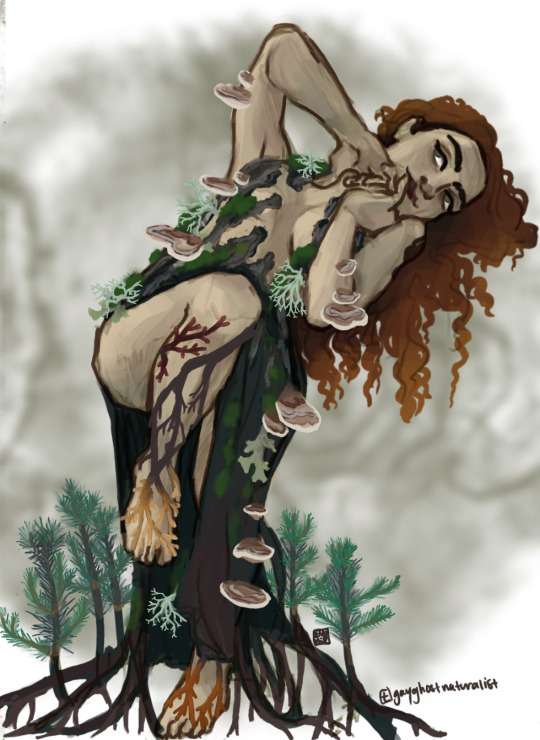
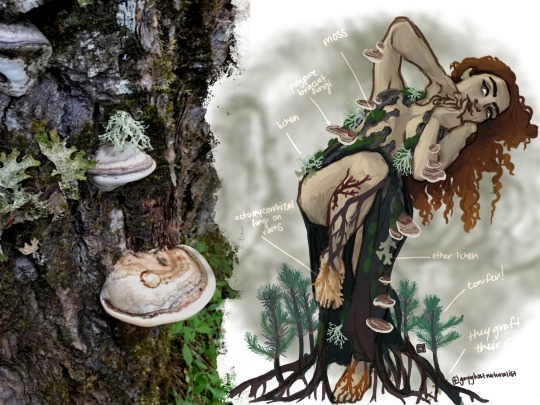
I am soooo normal about her. And I’m reading ‘The Mother Tree’ (a book by a mycologist about mycorrhizal fungi). So I did a Poison Ivy study based on a picture I took on a field trip with other botanists in Alaska.
#poison ivy but she’s an actual botanist#poison ivy#pamela isley#poison ivy fanart#poison ivy dc#poison ivy art#botany#ectomycorrhizal fungi#lichen#bracket fungi#art#fanart#botany in fiction#costume design#character design#dc#dc comics
707 notes
·
View notes
Text
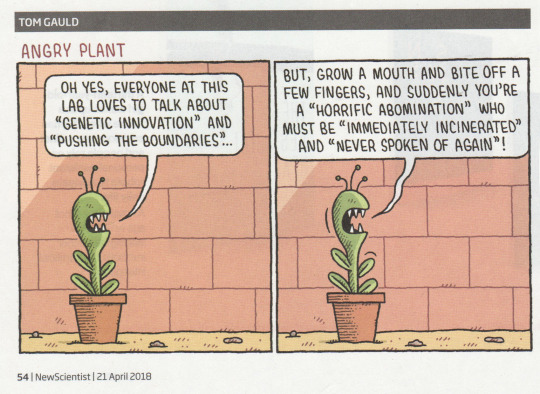
896 notes
·
View notes
Text
HOLY SHIT. GUYS GUESS WHAT???
so today in our botany class, our lecturer was teaching us about the types of fruits. and one of the types is called 'parthenocarpic' which means, the fruit is formed without fertilization taking place (basically the fruit is formed without plant sex lol) and GUESS WHAT? I GOT REMINDED OF ATHENA PARTHENOS. parthenocarpic.... parthenos.... sounds similar? and athena was born from the brain of zeus right??? without sex?? CRAZY.
#this is me studying#connecting studies with stuff i read in fiction#this actually makes a lot of sense#wow i'm genius#athena parthenos#biology#botany#percy jackson#pjo hoo toa#laya brags
318 notes
·
View notes
Text
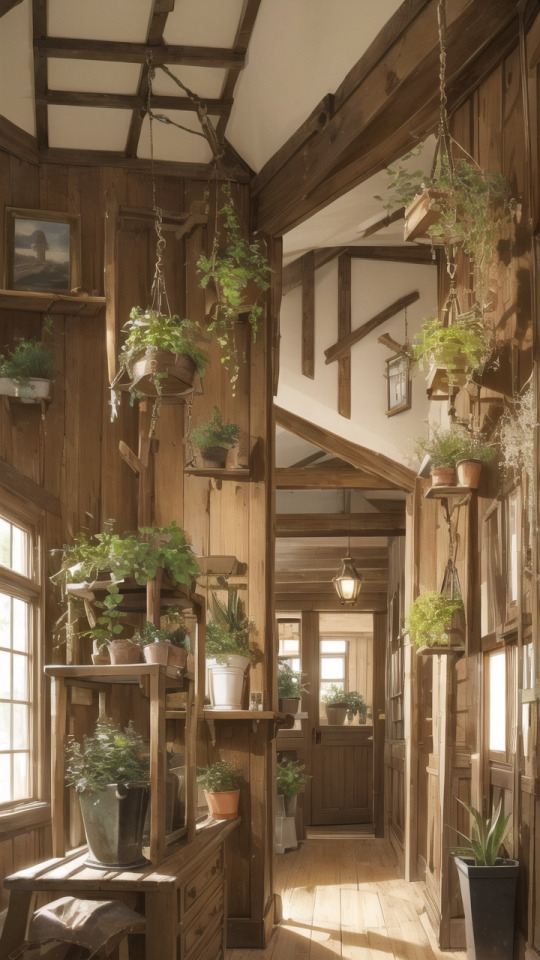


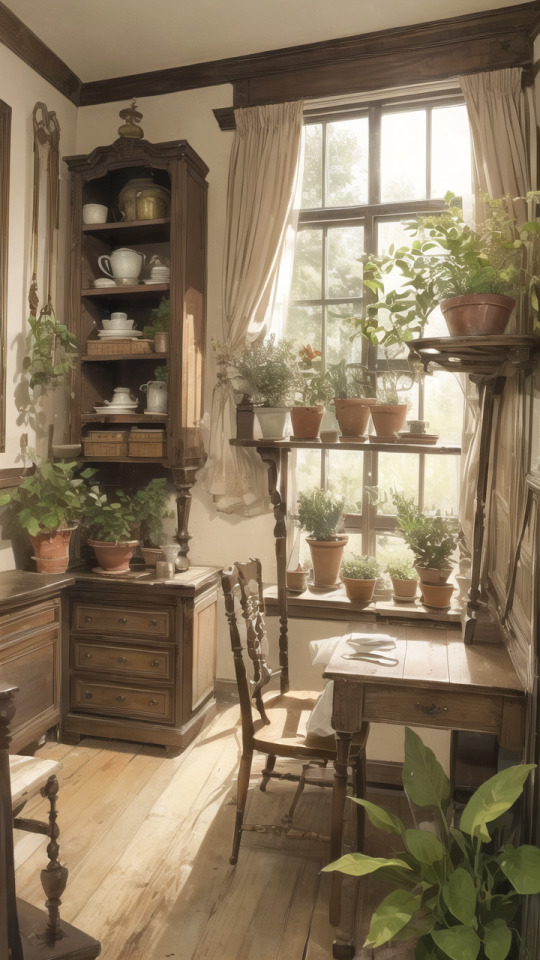
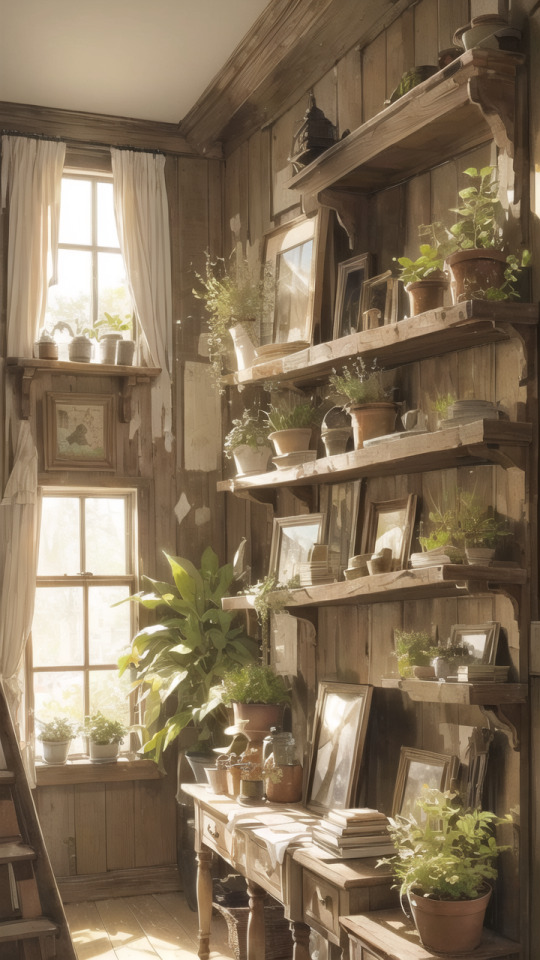
Oliver wants to take you to his home to look at his plants, which turns out not to be a sneaky euphemism, but most literal indeed. He adores plants! Adorably.
He says he chose not to study plants because he never wants to risk losing his love for them. Instead, he devotes his free time to saving all the struggling plants he comes across. We shall hope he never visits my place, lest he be inundated with dying herbs.
#lost in lyndoria#nature#interior design#interiors#interior#plantlife#plants#botany#garden#art#cozymood#cozy#cozy living#cottagecore#cottage aesthetic#cottage vibes#story#narrative#fiction#story time#reader pov
80 notes
·
View notes
Photo
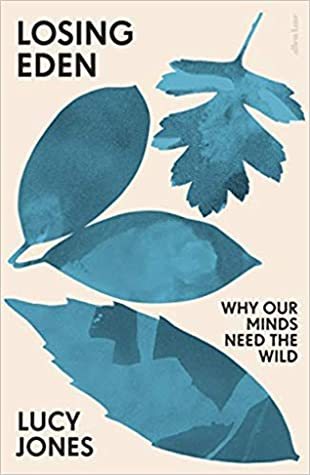



One with Nature: Connecting with the Natural World
Losing Eden: Why Our Minds Need the Wild by Lucy Jones
Today many of us live indoor lives, disconnected from the natural world as never before. And yet nature remains deeply ingrained in our language, culture and consciousness. For centuries, we have acted on an intuitive sense that we need communion with the wild to feel well. Now, in the moment of our great migration away from the rest of nature, more and more scientific evidence is emerging to confirm its place at the heart of our psychological wellbeing. So what happens, asks acclaimed journalist Lucy Jones, as we lose our bond with the natural world--might we also be losing part of ourselves?
Delicately observed and rigorously researched, Losing Eden is an enthralling journey through this new research, exploring how and why connecting with the living world can so drastically affect our health. Travelling from forest schools in East London, to the Svalbard Global Seed Vault, via Poland's primeval woodlands, Californian laboratories and ecotherapists' couches, Jones takes us to the cutting edge of human biology, neuroscience and psychology, and discovers new ways of understanding our increasingly dysfunctional relationship with the earth. Urgent and uplifting, Losing Eden is a rallying cry for a wilder way of life - for finding asylum in the soil and joy in the trees - which might just help us to save the living planet, as well as ourselves, from a future of ecological grief.
Braiding Sweetgrass: Indigenous Wisdom, Scientific Knowledge, and the Teachings of Plants by Robin Wall Kimmerer
As a botanist, Robin Wall Kimmerer has been trained to ask questions of nature with the tools of science. As a member of the Citizen Potawatomi Nation, she embraces the notion that plants and animals are our oldest teachers. In Braiding Sweetgrass, Kimmerer brings these lenses of knowledge together to show that the awakening of a wider ecological consciousness requires the acknowledgment and celebration of our reciprocal relationship with the rest of the living world. For only when we can hear the languages of other beings are we capable of understanding the generosity of the earth, and learning to give our own gifts in return.
Finding the Mother Tree: Discovering the Wisdom of the Forest by Suzanne Simard
From the world's leading forest ecologist who forever changed how people view trees and their connections to one another and to other living things in the forest--a moving, deeply personal journey of discovery.
Suzanne Simard is a pioneer on the frontier of plant communication and intelligence; she's been compared to Rachel Carson, hailed as a scientist who conveys complex, technical ideas in a way that is dazzling and profound. Her work has influenced filmmakers (the Tree of Souls of James Cameron's Avatar) and her TED talks have been viewed by more than 10 million people worldwide.
Now, in her first book, Simard brings us into her world, the intimate world of the trees, in which she brilliantly illuminates the fascinating and vital truths--that trees are not simply the source of timber or pulp, but are a complex, interdependent circle of life; that forests are social, cooperative creatures connected through underground networks by which trees communicate their vitality and vulnerabilities with communal lives not that different from our own.
The Vanishing Face of Gaia: A Final Warning by James E. Lovelock
Celebrities drive hybrids, Al Gore won the Nobel Peace Prize, and supermarkets carry no end of so-called “green” products. And yet the environmental crisis is only getting worse. In The Vanishing Face of Gaia, the eminent scientist James Lovelock argues that the earth is lurching ever closer to a permanent “hot state” – and much more quickly than most specialists think. There is nothing humans can do to reverse the process; the planet is simply too overpopulated to halt its own destruction by greenhouse gases.In order to survive, mankind must start preparing now for life on a radically changed planet. The meliorist approach outlined in the Kyoto Treaty must be abandoned in favor of nuclear energy and aggressive agricultural development on the small areas of earth that will remain arable.
A reluctant jeremiad from one of the environmental movement’s elder statesmen, The Vanishing Face of Gaia offers an essential wake-up call for the human race.
#nonfiction#non-fiction#non-fiction books#history#Environment#biology#botany#nature#natural science#sustainability#science#ecology#to read#tbr#booklr#book blog#reading recommendations#Book Recommendations#book recs#library books#informed reading#reading for a better world
215 notes
·
View notes
Text
Through the years (1/3)

I am literally so proud of this and if Tumblr crunches the quality I WILL cry
#i really like my adult kai design i could stare at it forever#he's so character i love him#i forgot to add Chocolate Chip in the future portion oops#selfship art#self ship art#queerplatonic selfship#queerplatonic self ship#queerplatonic selfshipping#queerplatonic self shipping#queerplatonic fictional other#queerplatonic f/o#🌲📖 botanical warden | kai#s/i | cel branch | dark parables#queerplatonic ship | botany and baking#pet f/o | chocolate chip the mist wolf#💛❤️💜 brought together by fate 💜❤️💛
8 notes
·
View notes
Text

Halloween Countdown Day 2
Dr. Zerlina Euphorbia the Mad Plant Scientist
Meet my first terrifying costume character of 2023 - a rage-filled botanist who seeks revenge against those who cut off her research funding and spread misinformation about the aims of her work on genetically modified plants!
Dr. Euphorbia was once an earnest woman in science who wanted to use genetic modification of plants to help solve the problem of world hunger and climate change, but as she was slighted and stymied at every stage of her career she eventually became jaded and bitter. Now, she cares not for public approval or philanthropic goals. She works in a secret lab and greenhouse developing genetically modified plants for EVIL purposes!
Do you dare enter the lair of Dr. Euphorbia? You may end up as the next meal of her giant Nepenthes plant or as fertiliser for her garden...
#Halloween#madscientist#halloweencostume#sciencefiction#science#plants#botany#labcoat#legs#darkmakeup#scary#femininerage
#katia plant scientist#botany#plant biology#katia hougaard#plant science#plants#greenhouse#green academia#green aesthetic#green#mad science#mad scientist#women in science#halloween#halloween costumes#happy halloweeeeeeen#halloween countdown#dark makeup#labcore#science fiction#science#sciencecore#biologist#euphorbiaceae#evil#evil scientist#characters#lab coat#high heels#fishnets
9 notes
·
View notes
Text
Entry 32
Graveroot
radix purgatio
Indigenous all over planet RA657-4, Graveroot is a species of creeping flower that grows almost exclusively over dead and decaying fauna. It's believed that during the early stages of decomposition, the chemicals produced by a cadaver activate long dormant seeds lying in the soil. Within 3 days after death, the body is consumed in a casket of roots, vines, and angelic purple flowers that shimmer under the night sky a billion different colours. KBL staff stationed on the planet have started using the flowers for ceremonial purposes; planting seeds onto fallen comrades before burials so that in less than a week, a makeshift gravemarker will appear. While this practice is explicitly prohibited by KBL, many still continue this practice to give peace to those lost so far from home.
2 notes
·
View notes
Text
Adventures Of The USS Helicon: Mind Bloom
Next episode in VNVdarkangel and my Love Live X Star Trek AU. Nozomi and Eli in danger, Maki making medical discoveries, and Rin and Nico excelling at their jobs.
#Love Live#Star Trek#NozoEli#Nozomi Tojo#Eli Ayase#NicoMaki#Nishikino Maki#Yazawa Nico#Sonoda Umi#Hoshizora Rin#medical distress#flirting#science fiction#science#xeno botany#fungal spores#relationship building#OCs#USS Helicon
2 notes
·
View notes
Note
Krimi maybe!
(Und jetzt hab ich nen Ohrwurm :D)
Von "Teufelskreis"? :D
Heh, krimi maybe ist ein winziges Stück Fanfic, aus dem vielleicht mal eine voll entwickelte case fic...erwächst. 🌱
Wieder in Richtung Ritualmord, diesmal mit Bäumen (🌳) statt mit Heiligen:
„Das ist vermutlich von ‘ner Silber-Linde. Tilia tomentosa.“
[Figur A] zog die Brauen hoch und nahm die Tüte wieder an sich. [Figur...L] trat ein Stück näher. „Können Sie uns auch sagen, wo wir eine finden könnten?“
„Na ja, das findet man übers städtische Baumkataster.“
„Haben Sie da Zugriff drauf?“
[Figur X] sah die beiden an und gab nach. „Kommen Sie rein, ich schau nach.“
#und ja. es ist hörk#natürlich#figuren noch ausgeklammert weil ich den pov und damit die anrede definitiv nochmal ändern werde#botany#partly truth and partly fiction#danke! <3#fanfiction#ask thingy#loquor#german stuff
7 notes
·
View notes
Text
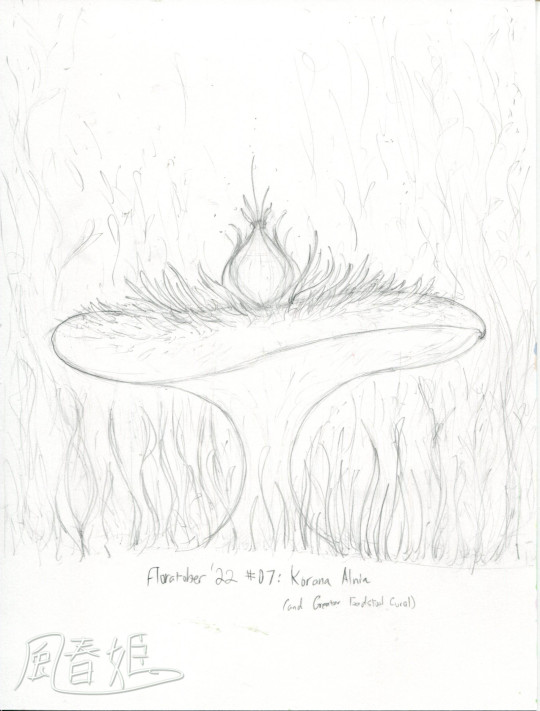
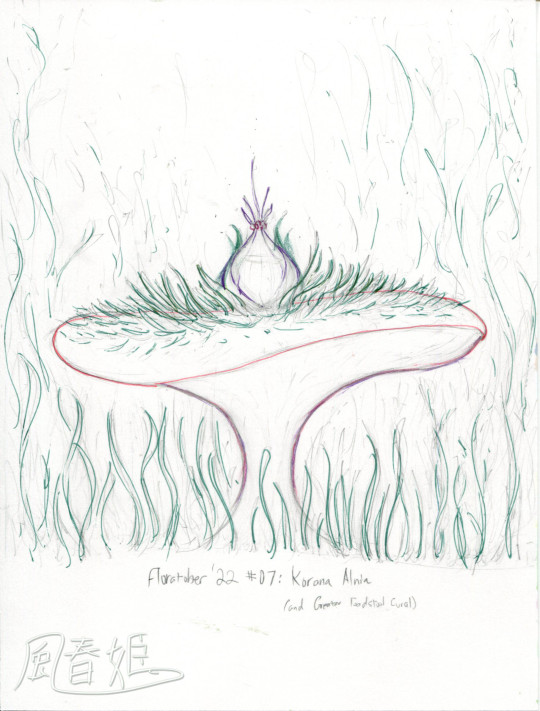
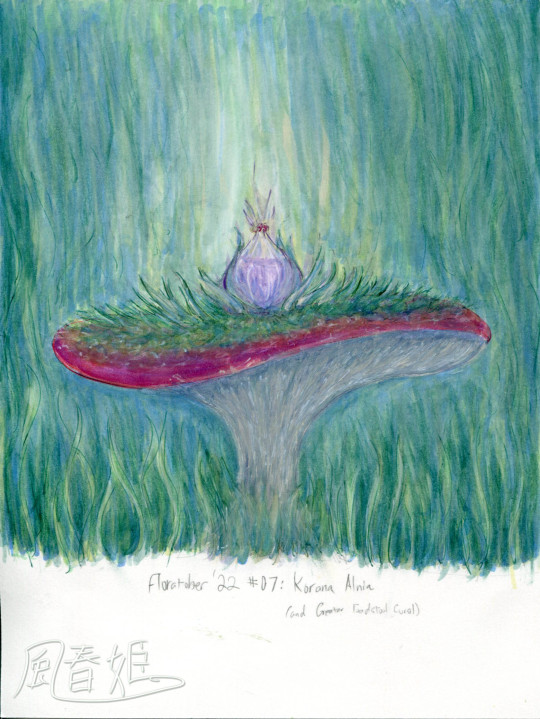
Korana Alnia
The larger, solitary relative of Korana Minia. Similar to the Minia, the Alnia stores a heavy, syrupy liquid like that of cough syrup. It has a sweet, medicinal taste that tends not to mesh well with other flavors. While it's culinary use is not yet fully understood, it is generally appreciated more for its aesthetics.
Alnias are always found on flat corals, and for a while it was thought that the plant itself was a hybrid of coral and plant. However, it is now understood that the plant is merely epiphytic and has a symbiotic relationship with the corals it grows on.
Alnias prefer to grow in warm, shallow water, with plenty of access to sunlight. It is thought that the taste of its nectar is stronger the deeper the plant grows. It is definitely known, however, that ones that grow deeper tend to be smaller than those that grow in shallower water.
They are found near Koraln Sing and in some of its interior basins.
#art#drawing#artists on tumblr#traditional art#fictional botany#markers#Prismacolor markers#Artist's Loft markers#Copic markers#Posca#Korana Alnia#JI#JI Planet#KnL#Koraln Sing#Floratober#Floratober 2022#aquatic plant#Alnia family
10 notes
·
View notes
Note
Hello! I have a question and I would like to know the opinion of an expert. If Ivy causes accelerated plant growth to gigantic proportions in a certain area, does this lead to soil depletion in this area?
You have asked one of the most complicated (and fascinating) questions someone could possibly ask, which I’ve also been trying to figure out. So! I have spent days looking through Environmental Microbiology (Pepper et al., 2015) to wrap my mind around it.
Here’s a suitably unhinged delve into soils, which are the most complicated and diverse ecosystem on the planet :’) are rapidly disappearing and can take hundreds of years to form. And a bit about why I started Pamela with cyanobacteria.
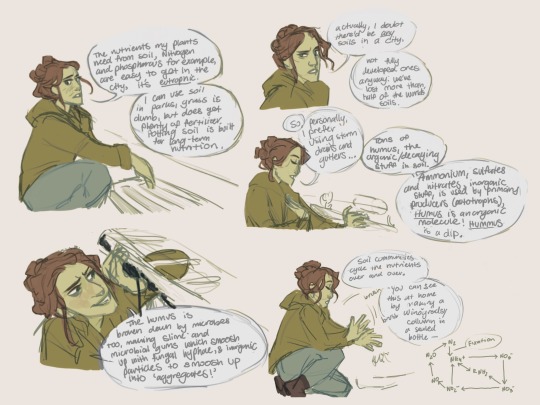
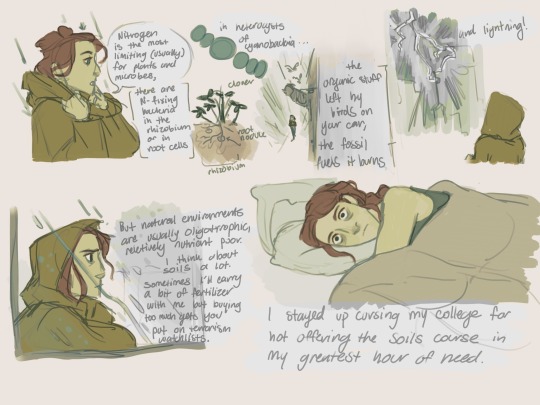



Tldr: YES?
If these are real, oligotrophic Soils, nitrogen (which is usually the most limiting thing plants need from soil) you would need enough to be about 12% of each dry cell’s weight. So, you would have to provide your own nitrogen fertilizer or use all the available nitrogen, probably inorganic nitrogen salts, Or it just wouldn’t grow in the first place.
Hope this helps? This is very short for soils too, they’re way more complex and interesting than I can express here. And I think it’s interesting to know how she would get what she needs in a city.
#asks#soils#poison ivy but she’s an actual botanist#microbiology#science fiction#science#poison ivy#botany#botany in science fiction
132 notes
·
View notes
Text
A juvenile gryphon of mine (species: vaarvaht) looking over a sight completely foreign to a desert dweller such as himself (an icy creek with many shrubs and fungal trees)
Plants on the exoplanet "Borea" where this vaarvaht is native to are almost completely black, with a blue-green glaze. Borea is the 5th planet out of 11 in its solar system, orbiting a star around 2% more massive than our sun, and somewhat brighter. It's relatively far from its sun within the "Goldilocks Zone", meaning plants would become black in the best attempt to absorb what it can. Some plants have even evolved to operate without heat. The general time is a summer afternoon, where Borea's equator would heat up to a scorching 9C/48F. Even with it's sun high in it's atmosphere, Borea's skies still look like an early, overcast morning. So, many organisms must compensate by producing light of their own.

#speculative evolution#original content#speculative biology#speculative exoplanet#speculative botany#speculative mycology#speculative mythology#gryphon#mythical creatures#speculative fiction#xenobiology#exobiology#tumblr fucked my art and now it's all roughed up
9 notes
·
View notes
Text
Didn’t work on anything; but instead downloaded about thirty-five new ebooks and PDFs because I panicked at the political state of the world United States and went “oh shit I need to be hoarding media at risk of being banned and if I don’t do this right now everyone will die.” 🙃
#*technically* I’m not a crazy person… but still#can I focus pls#anyway I now own lots and lots of gay books and informational books about fascism#and also an anxiety and depression workbook#(not that the latter would ever be banned but I just saw it and had to have it even though I’ll probably never use it (which is ironic))#so hmu if you desire them and I will provide#I have fiction too…#media psychology and forensic botany textbooks from the 30 day free trial I milked like a cow#I still haven’t ripped into media psychology yet… damn I should do that it seems extremely interesting
3 notes
·
View notes
Text
... zoya really sits somewhere between nausicaa and san on the ghibli heroine spectrum huh
#they both are nature oriented princesses#zoya has san's ferocity but also nausicaa's drive to form some sort of harmony between man and nature#while san believes the two will never be able to truly coexist without one inevitably destroying the other#wind and wild princesses plus zoya is more inclined toward study and botany which is also very nausicaa of her#it's blue motif for me and the chosen one subversion narrative#𝖎𝖎. *ੈ ˖ ° ⥽ carlisle cullen? no carly rae cullen ⥼ ⅋. ooc#i will compile a list of fictional inspo for zoya i am pretty open about her mythological inspirations so this is the next step#sickening that the only dragon in these movies is haku and he couldn't be less like zoya bnrjytn
4 notes
·
View notes
Text
Welcome to the Science Pit
Tags I use:
----
Scale of Realism:
#reality -self explanatory, this is usually research-related and describes a real phenomenon.
#shitpost -Science related shitpost. May overlap with reality, may not.
#fiction -Fictional science stuff, has sub-categories.
#PSA -This post contains information which is important and should be spread for safety or other reasons.
----
Under Fiction:
#scifi -science fiction. Aliens and stuff.
#fantasy -unicorn and dragon-type science.
#speculative science/culture/biology/fiction - fiction that speculates on scientific topics.
#mad science - fiction centering on mad science.
----
Specific Sciences (all self-explanatory):
#biology
#zoology
#botany
#chemistry
#organic chemistry
(Note: there are other more specific tags, but these are the umbrella tags.)
----
Miscellaneous Zoology/Animal Specific:
#human intervention (positive) -positive interaction between humans and animals- often domestic animals or professional rehabilitators
#human intervention (negative) - Negative interactions between humans and animals- think humans with exotic pets or feeding wildlife or mistreating domestic animals.
#dangerous interactions -interactions between species that are unsafe for one or both parties, like cats and birds or other predator/prey interactions in domestic situations.
#cute animal - Critters considered conventionally cute- cats, dogs, raccoons, etcetera. This tag will be excluded from dangerous or negative interaction posts for obvious reasons.
#unconventional cute animal - Critters I consider cute, doing cute things. May include arthropods.
#predator prey - interactions in the predator-prey dynamic. Involves suffering or death by one party to sustain the other.
----
My Additions (stuff I add to the conversation):
#Kenopsia commentary - my commentary, not necessarily adding new information.
#Kenopsia explains - me trying to explain a phenomenon.
#home science advice - my advice on little bits of science you can do at home safely (birdwatching, for example)
----
Miscellaneous tags:
#death - post contains explicit talk of death.
#bugs - post contains arthropods that some may find upsetting. This is not a scientific tag.
This post is tagged with all of the tags listed above for ease of navigation.
#speculative science#biology#reality#shitpost#speculative culture#speculative biology#speculative fiction#chemistry#zoology#botany#fiction#scifi#fantasy#mad science#organic chemistry#home science advice#cute animal#PSA#human intervention (positive)#human intervention (negative)#dangerous interaction#predator prey#death#bugs#unconventional cute animal#Kenopsia commentary#Kenopsia explains
2 notes
·
View notes